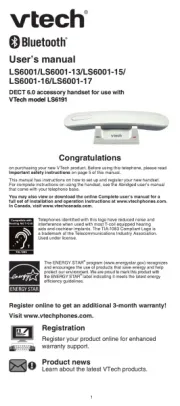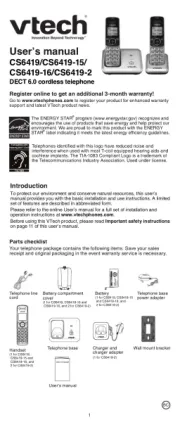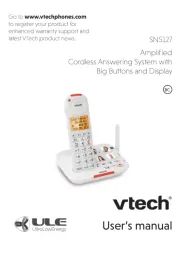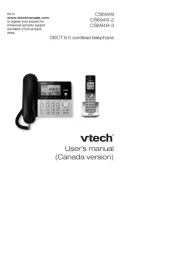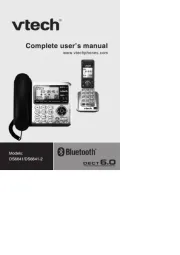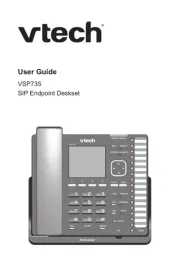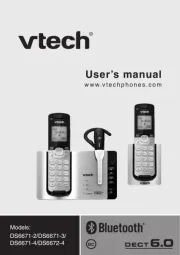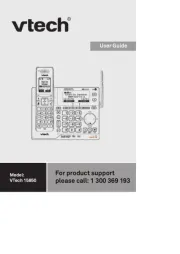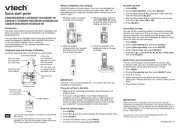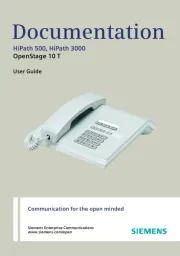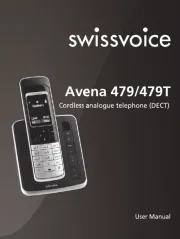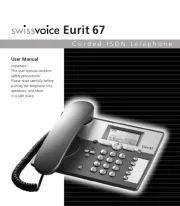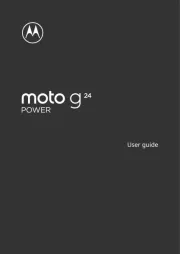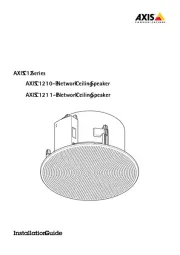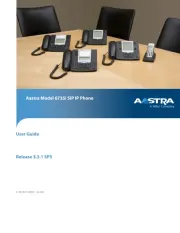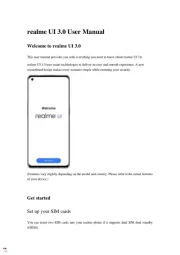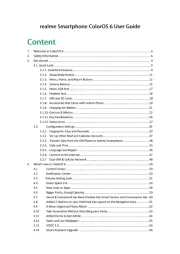
Congratulations
on purchasing your new VTech product. Before
using this telephone, please read
Important safety instructions.
This manual has instructions on how to set up
and register your new handset. For instructions
on using the handset, see the Abridged user’s
manual that came with your telephone base.
You may also view or download the online
user’s manual for a full set of installation and
operation instructions at
www.vtechphones.com. In Canada, visit
www.vtechcanada.com.
Parts checklist
Your telephone package contains the following
items. Save your sales receipt and original
packaging in the event warranty service is
necessary.
Charger overview
1 – Charging pole
Handset overview
1 – Handset earpiece
2 – LCD display
3 –
• Show the menu.
• While in a menu, press to select an item, or
save an entry or setting.
4 –
Hang up a call.
Silence the ringer temporarily while the
handset is ringing.
Press and hold to erase the missed call
indicator while the phone is not in use.
Press to return to the previous menu; or
press and hold to return to idle mode, without
making changes.
5 –
Press repeatedly to show other dialing
options when reviewing a caller ID log entry.
6 –
Press to start an intercom conversation
or transfer a call (for multi-handset models
only).
7 – Microphone
8 –
• Mute the microphone during a call.
• Delete digits or characters while using the
dialing keys.
Silence the ringer temporarily while the
handset is ringing.
•
•
•
•
•
•
•
9 –
Make or answer a call using the handset
speakerphone.
During a call, press to switch between the
speakerphone and the handset earpiece.
10 –
• While you have set the dial mode to pulse
and on a call, press to switch to tone dialing
temporarily.
11 –
Press to add a space when entering names.
12 –
• Press repeatedly to add or remove 1 in front
of the caller ID log entry before dialing or
saving it to the phonebook.
• Press and hold to set or dial your voicemail
number.
13 –
• Make or answer a call.
• Answer an incoming call when you hear a call
waiting alert.
14 –
• Press repeatedly to review the redial list.
• Press and hold to insert a dialing pause while
entering a number.
15 –
• Review the phonebook when the phone is not
in use.
• Increase the listening volume during a call.
• Scroll up while in a menu, or in the
phonebook, caller ID log, or redial list.
• Move the cursor to the right when entering
numbers or names.
Review the caller ID log when the phone is not
in use.
Decrease the listening volume during a call.
Scroll down while in a menu, or in the
phonebook, caller ID log, or redial list.
Move the cursor to the left when entering
numbers or names.
16 – light
• On when the handset is charging.
•
•
•
•
•
•
•
Display icons overview
Install the battery
Install the battery as shown below.
Use only the battery provided.
If the handset will not be used for a long time,
disconnect and remove the battery to prevent
possible leakage.
•
•
Connect and charge the battery
Use only the power adapter supplied with this
product.
Charge the battery provided with or identified for
use with this product only in accordance with the
instructions and limitations specified in this manual.
Connect the charger
Charge the battery
Place the handset in the charger to charge.
Once you have installed the battery, the
handset LCD display indicates the battery
status (see the following table).
For best performance, keep the handset in the
telephone base or charger when not in use.
The battery is fully charged after 12 hours of
continuous charging.
•
•
•
•
Battery
indicators
Battery status Action
The screen
is blank, or
shows Put in
charger and
flashes.
The battery
has no charge
or very little
charge. The
handset cannot
be used.
Charge without
interruption
(at least 30
minutes).
The screen
shows Low
battery and
flashes.
The battery has
enough charge
to be used for a
short time.
Charge without
interruption
(at least 30
minutes).
The screen
shows
HANDSET X.
The battery is
charged.
To keep the
battery charged,
place it in the
telephone base
or charger when
not in use.
Before use
Add and register a handset
You can add new CS6909 handsets (purchased
separately) to your CS6919/CS6929 telephone
system. Your telephone system supports a
maximum of five handsets.
Each handset must be registered with the
telephone base before use. When first
purchased, each expansion handset displays To
register HS... and ...see manual alternatively.
Charge the new handset without interruption for
at least 30 minutes before registering it to the
telephone base.
To register a handset to the telephone base:
Place the new handset in the telephone
base.
•
•
After about 10 seconds, the handset displays
Registering.... When the registration process
completes, the handset displays Registered
and you hear a beep. The registration process
takes about 90 seconds.
Deregister handsets
If you want to replace a handset or reassign
the designated handset number of a registered
handset, you must deregister all the handsets
and then individually register each handset.
If you want to register a handset to another
telephone base, you must deregister all
handsets, and then register each handset
individually to the desired telephone base. to the desired telephone base.
To deregister all handsets from the
telephone base:
1. Press and hold FIND HANDSET on the
telephone base for about 10 seconds until
the IN USE light on the telephone base
turns on and starts flashing.
2. Immediately press FIND HANDSET again.
You must press FIND HANDSET while the
IN USE light is still flashing. The IN USE
light turns off, and you hear a confirmation
tone.
3. All handsets display To register HS...
and ...see manual alternately when the
deregistration process completes. The
deregistration process takes about 10
seconds.
Operating range
This cordless telephone operates with the
maximum power allowed by the Federal
Communications Commission (FCC). Even
so, this handset and telephone base can
communicate over only a certain distance
- which can vary with the locations of the
telephone base and handset, the weather, and
the layout of your home or office.
When the handset is out of range, the handset
displays Out of range or no pwr at base.
If there is a call while the handset is out of
range, it may not ring, or if it does ring, the call
may not connect well when you press . Move
closer to the telephone base, and then press
to answer the call. If the handset moves out
of range during a telephone conversation, there
may be interference. To improve reception,
move closer to the telephone base.
ECO mode
This power conserving technology reduces
power consumption for optimal battery
performance. The ECO mode activates
automatically whenever the handset is
synchronized with the telephone base.
General product care
Taking care of your telephone
Your cordless telephone contains sophisticated
electronic parts, so it must be treated with care.
Avoid rough treatment
Place the handset down gently. Save the
original packing materials to protect your
telephone if you ever need to ship it.
Avoid water
Your telephone can be damaged if it gets wet.
Do not use the handset outdoors in the rain,
or handle it with wet hands. Do not install the
telephone base near a sink, bathtub or shower.
Electrical storms
Electrical storms can sometimes cause power
surges harmful to electronic equipment. For your
own safety, take caution when using electrical
appliances during storms.
Cleaning your telephone
Your telephone has a durable plastic casing that
should retain its luster for many years. Clean it
only with a dry non-abrasive cloth. Do not use
dampened cloth or cleaning solvents of any kind.
Important safety instructions
When using your telephone equipment, basic
safety precautions should always be followed to
reduce the risk of fire, electric shock and injury,
including the following:
Read and understand all instructions.
Follow all warnings and instructions marked
on the product.
Unplug this product from the wall outlet
before cleaning. Do not use liquid or aerosol
cleaners. Use a damp cloth for cleaning.
Do not use this product near water such as
near a bath tub, wash bowl, kitchen sink,
1.
2.
3.
4.
laundry tub or swimming pool, or in a wet
basement or shower.
Do not place this product on an unstable
table, shelf, stand or other unstable
surfaces.
Avoid placing the telephone system in
places with extreme temperature, direct
sunlight, or other electrical devices. Protect
your phone from moisture, dust, corrosive
liquids and fumes.
Slots and openings in the back or bottom
of the telephone base and handset are
provided for ventilation. To protect them
from overheating, these openings must not
be blocked by placing the product on a soft
surface such as a bed, sofa or rug. This
product should never be placed near or
over a radiator or heat register. This product
should not be placed in any area where
proper ventilation is not provided.
This product should be operated only from
the type of power source indicated on the
marking label. If you are not sure of the
type of power supply in your home or office,
consult your dealer or local power company.
Do not allow anything to rest on the power
cord. Do not install this product where the
cord may be walked on.
Never push objects of any kind into this
product through the slots in the telephone
base or handset because they may touch
dangerous voltage points or create a short
circuit. Never spill liquid of any kind on the
product.
To reduce the risk of electric shock, do
not disassemble this product, but take it to
an authorized service facility. Opening or
removing parts of the telephone base or
handset other than specified access doors
may expose you to dangerous voltages
or other risks. Incorrect reassembling can
cause electric shock when the product is
subsequently used.
Do not overload wall outlets and extension
cords.
Unplug this product from the wall outlet
and refer servicing to an authorized service
facility under the following conditions:
When the power supply cord or plug is
damaged or frayed.
If liquid has been spilled onto the
product.
If the product has been exposed to rain
or water.
If the product does not operate normally
by following the operating instructions.
5.
6.
7.
8.
9.
10.
11.
12.
13.
•
•
•
•
Adjust only those controls that are
covered by the operation instructions.
Improper adjustment of other controls
may result in damage and often requires
extensive work by an authorized
technician to restore the product to
normal operation.
If the product has been dropped and the
telephone base and/or handset has been
damaged.
If the product exhibits a distinct change in
performance.
14. Avoid using a telephone (other than
cordless) during an electrical storm. There is
a remote risk of electric shock from lightning.
15. Do not use the telephone to report a gas
leak in the vicinity of the leak. Under certain
circumstances, a spark may be created
when the adapter is plugged into the power
outlet, or when the handset is replaced in its
cradle. This is a common event associated
with the closing of any electrical circuit. The
user should not plug the phone into a power
outlet, and should not put a charged handset
into the cradle, if the phone is located in
an environment containing concentrations
of flammable or flame-supporting gases,
unless there is adequate ventilation. A spark
in such an environment could create a fire or
explosion. Such environments might include:
medical use of oxygen without adequate
ventilation; industrial gases (cleaning
solvents; gasoline vapors; etc.); a leak of
natural gas; etc.
16. Only put the handset of your telephone next
to your ear when it is in normal talk mode.
17. The power adapters are intended to be
correctly oriented in a vertical or floor mount
position. The prongs are not designed to
hold the plug in place if it is plugged into a
ceiling, under-the-table or cabinet outlet.
SAVE THESE INSTRUCTIONS
Battery
CAUTION: Use Only Supplied Battery.
Do not dispose of the battery in a fire. Check
with local waste management codes for
special disposal instructions.
Do not open or mutilate the battery. Released
electrolyte is corrosive and may cause burns
or injury to the eyes or skin. The electrolyte
may be toxic if swallowed.
Exercise care in handling batteries in
order not to create a short circuit with
conductive materials.
•
•
•
•
•
•
Charge the battery provided with or identified
for use with this product only in accordance
with the instructions and limitations specified
in this manual.
Precautions for users of implanted
cardiac pacemakers
Cardiac pacemakers (applies only to digital
cordless telephones):
Wireless Technology Research, LLC (WTR),
an independent research entity, led a
multidisciplinary evaluation of the interference
between portable wireless telephones and
implanted cardiac pacemakers. Supported by
the U.S. Food and Drug Administration, WTR
recommends to physicians that:
Pacemaker patients
Should keep wireless telephones at least six
inches from the pacemaker.
Should NOT place wireless telephones
directly over the pacemaker, such as in a
breast pocket, when it is turned ON.
Should use the wireless telephone at the ear
opposite the pacemaker.
WTR’s evaluation did not identify any risk to
bystanders with pacemakers from other persons
using wireless telephones.
About cordless telephones
Privacy: The same features that make a
cordless telephone convenient create some
limitations. Telephone calls are transmitted
between the telephone base and the
cordless handset by radio waves, so there
is a possibility that the cordless telephone
conversations could be intercepted by radio
receiving equipment within range of the
cordless handset. For this reason, you should
not think of cordless telephone conversations
as being as private as those on corded
telephones.
Electrical power: The telephone base of this
cordless telephone must be connected to a
working electrical outlet. The electrical outlet
should not be controlled by a wall switch.
Calls cannot be made from the cordless
handset if the telephone base is unplugged,
switched off or if the electrical power
is interrupted.
Potential TV interference: Some cordless
telephones operate at frequencies that may
cause interference to televisions and VCRs.
To minimize or prevent such interference, do
not place the telephone base of the cordless
telephone near or on top of a TV or VCR.
If interference is experienced, moving the
•
•
•
•
•
•
•
cordless telephone farther away from the TV
or VCR often reduces or eliminates
the interference.
Rechargeable batteries: Exercise care in
handling batteries in order not to create a
short circuit with conducting material such
as rings, bracelets, and keys. The battery or
conductor may overheat and cause harm.
Observe proper polarity between the battery
and the battery charger.
Nickel-metal hydride rechargeable
batteries: Dispose of these batteries in a
safe manner. Do not burn or puncture the
battery. Like other batteries of this type, if
burned or punctured, they could release
caustic material which could cause injury.
The RBRC
®
seal
The RBRC
®
seal on the nickel-metal hydride
battery indicates that VTech Communications,
Inc. is voluntarily participating in an industry
program to collect and recycle these batteries
at the end of their useful lives, when taken out
of service within the United States and Canada.
The RBRC
®
program provides a convenient
alternative to placing used nickel-metal hydride
batteries into the trash or municipal waste,
which may be illegal in your area.
VTech’s participation in RBRC
®
makes it easy
for you to drop off the spent battery at local
retailers participating in the RBRC
®
program or
at authorized VTech product service centers.
Please call
1 (800) 8 BATTERY
®
for information
on Ni-MH battery recycling and disposal bans/
restrictions in your area. VTech’s involvement
in this program is part of its commitment to
protecting our environment and conserving
natural resources.
RBRC
®
and
1 (800) 8 BATTERY
®
are registered trademarks of
Rechargeable Battery Recycling
Corporation.
FCC, ACTA and IC regulations
FCC Part 15
This equipment has been tested and found
to comply with the requirements for a Class
B digital device under Part 15 of the Federal
Communications Commission (FCC) rules.
These requirements are intended to provide
reasonable protection against harmful
interference in a residential installation.
This equipment generates, uses and can
•
•
User’s manual
Telephones identified with this
logo have reduced noise and
interference when used with
most T-coil equipped hearing
aids and cochlear implants.
The TIA-1083 Compliant
Logo is a trademark of the
Telecommunications Industry
Association. Used under license.
User’s manual
The battery icon flashes when
the battery is low and needs
charging.
The battery icon animates when
the battery is charging.
The handset ringer is turned off.
There are new voicemail
received from your telephone
service provider.
ECO
The ECO mode activates
automatically to reduce power
consumption when the handset
is within range from the
telephone base.
NEW
There are new caller ID log
entries.
T
Compatible with
Hearing Aid T-Coil
TIA-1083
BC
CS6909
CS6909-15
CS6909-16
CS6909-17
CS6909-19
DECT 6.0 cordless telephone
Go to
www.vtechphones.com
to register your product for
enhanced warranty support
and latest VTech product
news.
CS6919 base
CS6929 base
Do not place
the handset in
the charger.
CS6919 base CS6929 base
